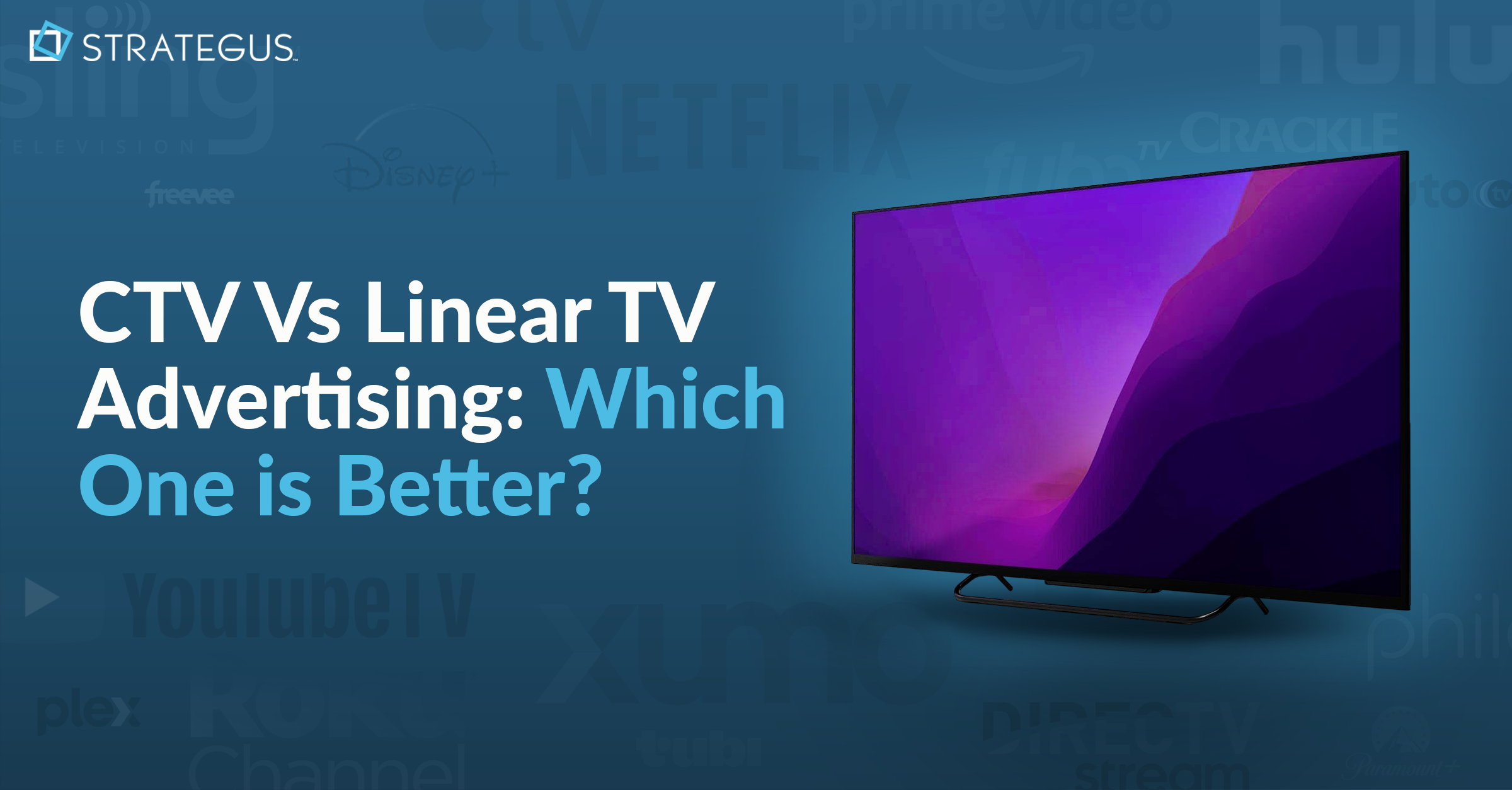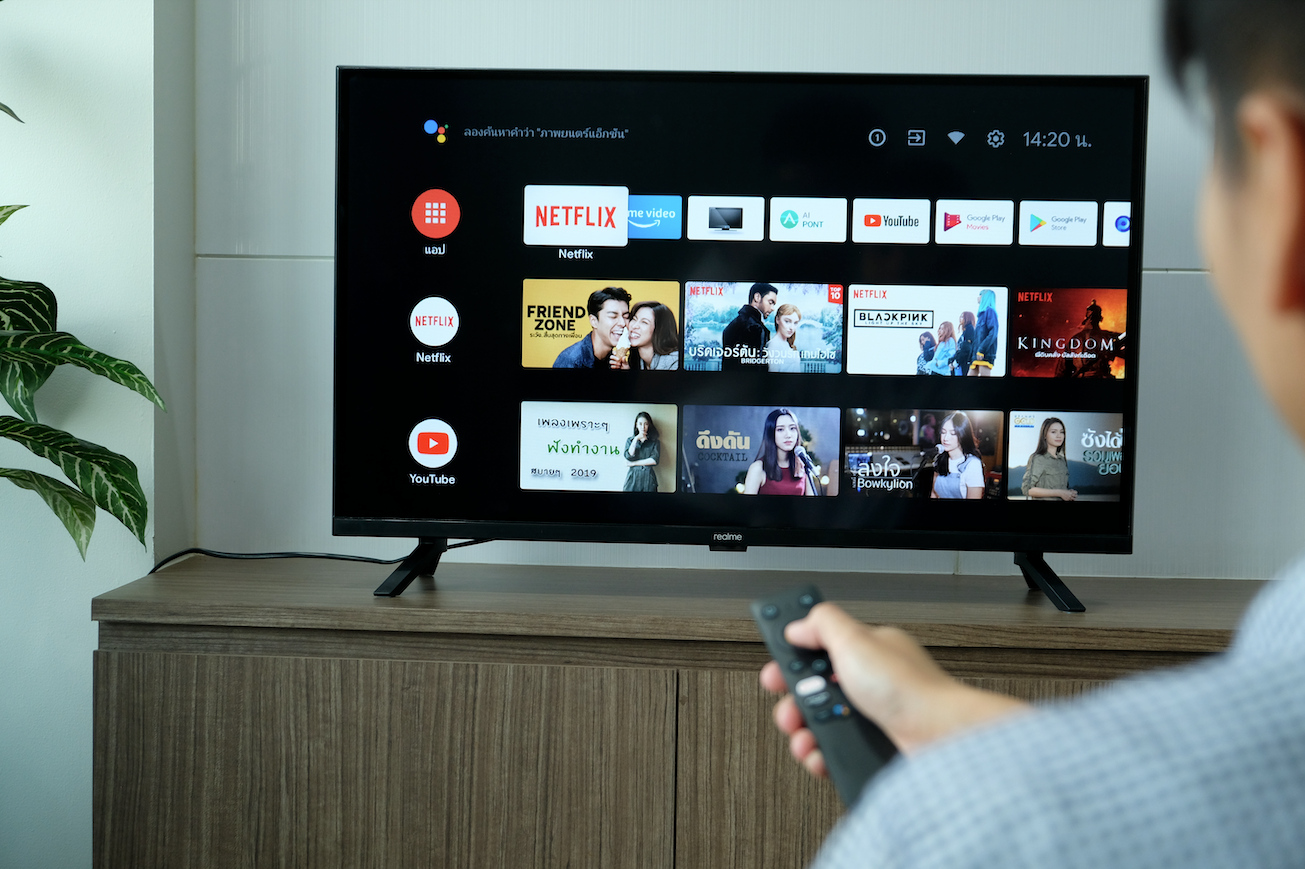- Home
- Strategus Blog
- CTV vs. Linear TV Advertising: Which One is Better?
CTV vs. Linear TV Advertising: Which One is Better?
 Andy Dixon
Andy Dixon
10 minutes read

Connected TV (CTV) has surged as more viewers become cord-cutters and cord-nevers.
For advertisers, this change makes CTV vital for reaching audiences who have left cable behind. At the same time, linear TV still holds value, especially for live events like sports.
The smartest strategy often blends both for maximum reach and impact. Read on and learn the difference between CTV & Linear TV, and how you can combine the two for best results.
Key Takeaways
- CTV advertising delivers targeted, trackable ads via streaming apps and devices, while linear TV broadcasts ads broadly to all viewers at a scheduled time.
- CTV benefits include household-level targeting, cross-device retargeting, real-time measurement, and flexibility, with 87% of US households owning connected TV devices.
- Linear TV offers unmatched scale during live events, strong credibility, and trusted ad placements, with 61 of the top 100 primetime broadcasts being sports.
- Linear impressions are less efficient, with Q1 2022 showing 94% of impressions reaching just 55% of viewers, while CTV adoption continues to climb across industries.
- Blending both channels extends reach, avoids wasted impressions, and ensures consistent cross-screen engagement by unifying brand awareness with measurable audience targeting.
- Combine CTV precision with linear scale for incremental reach and attribution across screens. Speak to a Strategus expert and launch smarter TV campaigns today.
CTV Vs Linear TV Advertising: What’s the Difference?
CTV advertising delivers ads through internet-connected devices like smart TVs and streaming apps, while linear TV advertising delivers ads through traditional cable or broadcast channels.
The main difference is how the ads reach viewers.
CTV targets audiences based on data, allowing advertisers to show ads to specific households or interests. It offers tracking, retargeting, and precise reporting. Linear TV, on the other hand, broadcasts ads to everyone watching a channel at a set time, making it better for mass reach but less precise.
For advertisers, CTV provides flexibility, measurable results, and cross-device targeting. Linear TV still works best for live events like sports or news where large audiences tune in together. Many brands now use both to balance precise targeting with broad exposure.

Now, let’s take a look at both in detail:
What is CTV Advertising?
CTV advertising is when brands place ads on internet-connected TVs and streaming platforms instead of traditional cable channels.
It works through smart TVs, devices like Roku, Apple TV, or Fire Stick, and apps such as Hulu, Peacock, or YouTube TV. Advertisers can use data like location, demographics, or viewing habits to target specific households instead of showing the same ad to everyone.
Brands can measure CTV campaigns and know how many people saw an ad, if they engaged with it, and whether they later visited a website or store. This level of precision and tracking makes CTV one of the most effective ways to reach modern audiences who have shifted away from cable.
Benefits of CTV Advertising
CTV advertising has its own list of perks that are making brands switch over to this form of advertising. Some of them are listed below:
1. Reach the Right Audience
CTV reaches households that have cut the cord or never had cable. It’s one of the fastest-growing segments in US digital ad spend. With 87% of US households now owning a connected TV device like Roku or Fire Stick, advertisers can target viewers based on age, location, interests, and behaviors, instead of showing ads to everyone.
2. Track Real Results
CTV provides clear, real-time reports on impressions, views, and outcomes. You can measure if someone visited your website or store after seeing your ad. Campaigns can also include QR codes, promo codes, or clickable links, giving full transparency between spend and performance.
3. Retarget Across Devices
Viewers often switch between TV, mobile, and laptops. CTV allows retargeting across these devices, so your message follows the same household and reinforces brand recall. This multi-screen approach strengthens engagement and consistency.
4. Flexible and Cost-Efficient
CTV campaigns can be adjusted in real time, focusing spend on top-performing audiences while cutting waste. Unlike fixed ad slots on linear, you control when and where your ads appear. This flexibility makes every impression count because you are reaching a more receptive audience.
5. Connect with Cord-Cutters
Cord-cutting has grown rapidly, and over 60% of people now identify TV to include streaming services. Millions of viewers who no longer watch cable spend hours on streaming platforms. CTV is the only way to reach them, making it essential if you want to stay relevant.

What is Linear TV Advertising?
Linear TV advertising is when brands place ads on traditional broadcast or cable channels that play at scheduled times.
With linear TV, ads are delivered to all viewers watching a program at the same time, so targeting is broad rather than personalized. Advertisers normally buy ad slots during specific shows, networks, or time blocks to reach large audiences.
This method is especially useful for live events like sports, news, or popular shows where millions tune in at once. While it lacks advanced tracking or household-level targeting, linear TV offers scale, brand awareness, and the ability to reach demographics that still rely heavily on cable or satellite.
Many national campaigns still use it to achieve widespread visibility.
Benefits of Linear TV Advertising
While linear TV advertising feels ancient compared to CTV, there are still benefits to investing in this advertising medium.
1. Reach Large Audiences at Once
Linear TV still dominates mass reach, especially through broadcast. In fact, 61 of the top 100 most-watched primetime broadcasts were sports events. Ads in these slots give your brand national visibility, ideal for awareness campaigns.
2. Build Brand Trust and Credibility
Traditional TV carries prestige and is often trusted more than digital channels. 62% of global consumers say they trust linear TV ads the most. Ads aired during major broadcasts strengthen credibility and brand image.
3. Dominate Live Events
Live sports, award shows, and breaking news still belong to linear TV. Even as streaming rises, 63% of Americans still subscribe to both cable and streaming. Advertising in these live moments helps capture attention when engagement is at its peak.
4. Simple Planning and Buying
Linear ad buying is straightforward. You can secure slots by network, program, or time of day, aligning with demographics tied to certain shows or channels. While targeting is less precise than CTV, it’s easier to plan and effective for broad exposure.
5. Strong Visibility for Certain Demographics
Linear still serves audiences less likely to cut the cord. For example, the median age of a linear TV viewer is 55 years old. If your product appeals to older viewers or households that stick with cable, linear remains a reliable way to reach them.
Which One Is Better – CTV or Linear TV?
The short answer is, it depends. The decision is based on your goals, but the trend clearly favors CTV.
Linear TV still delivers unmatched scale during live events like sports and award shows. It also offers credibility and wide national reach, but audience numbers are shrinking fast.
In Q1 2022, 94% of US linear ad impressions went to just 55% of viewers, showing that nearly half the audience saw very few ads. This makes linear less efficient for many marketers, even as ad prices rise.
CTV, on the other hand, continues to grow. Industries like travel, automotive, retail, and quick-service restaurants drove over 50% of video ad impressions on CTV, and adoption is still climbing as cord-cutting spreads.
With precise targeting, real-time measurement, and cross-device reach, CTV solves many of the gaps that make linear less effective today.
That said, the smartest advertisers don’t choose one side. They blend both, using linear for broad awareness and live moments, and CTV for targeted reach and measurable engagement.
Even the classic 30-second spot, once a linear staple, has carried over successfully to OTT and CTV, showing that the future of TV advertising is not about replacement but about evolution.
Blend CTV and Linear for Maximum Reach

While you might be inclined to choose one or the other, the answer may not be singular like you’re expecting. Here’s why combining both mediums delivers the strongest results:
Extend Your Campaign Effortlessly
With Linear TV Extension (LTVE), you can take the same ad used on broadcast, satellite, or cable and place it on streaming platforms like Roku. This requires little to no modification, making it simple to bridge the gap between traditional and connected TV.
Reach New Audiences Without Waste
Extending ads onto CTV/OTT ensures you connect with households who did not see your message on linear TV. This avoids wasted impressions, prevents oversaturating the same viewers, and expands your campaign’s reach to fresh demographics within your target market.
Create Consistent, Cross-Platform Impact
By blending linear and CTV, you keep your message in front of viewers across every screen. This increases brand recall, builds engagement, and boosts conversion rates, all while making the most of your ad spend. The combination creates a unified funnel that captures both broad awareness and precise targeting.
Closing Thoughts — Partner with Strategus for Smarter TV Advertising
Blending CTV and linear gives you the best of both worlds: scale, credibility, precision, and measurable impact. But managing both channels effectively can be complex without the right expertise. That’s where Strategus comes in.

With Strategus, you get:
- Access to premium CTV and OTT inventory, alongside linear TV extensions.
- Advanced targeting and retargeting that reaches audiences across every screen.
- Real-time measurement and attribution tools to prove ROI.
- A fully managed approach that removes the guesswork and maximizes your ad spend.
The future of TV advertising is not about choosing sides but creating a connected strategy that drives results.
Partner with us to build campaigns that reach the right people, at the right time, on the right screen. Speak to a Strategus expert to learn more today.
Frequently Asked Questions
1. How Do I Measure Incremental Lift to Improve Connected TV Performance?
Set up a clean test. Split similar geos or audiences into exposed and control groups. Run the same offer and timing. Track conversions, revenue, and visit rate in both groups. Calculate lift as exposed minus control. Repeat across creatives and segments. Keep frequency and reach balanced to avoid wasted impressions.
2. How Do Attention Metrics Differ for CTV vs Linear TV?
CTV lets you track ad completion rate, session depth, and post-view actions across devices. Linear focuses on ratings, reach, and average commercial minute. CTV attention looks tighter and links to outcomes more easily. Linear attention covers broad audiences but connects to outcomes through matchback, surveys, and modeled reach curves.
3. How Do Outcome-Linked Attention Metrics Guide a Product Launch Choice?
Tie attention to actions that matter. For CTV, track completion, site visits, and add-to-cart after exposure. For linear, run matchback studies and brand lift to see awareness and intent changes. Compare cost per outcome across both. Choose the mix that grows incremental reach while hitting trial, signups, or sales goals.
4. What Is the Best Way to Measure Linear TV Ad Effectiveness?
Define a primary outcome like sales or qualified site visits. Use geo split tests, holdouts, or time-based baselines. Match exposed households to outcomes with privacy-safe partners. Control for seasonality and promotions. Report cost per incremental outcome, not only GRPs. Layer brand lift to capture awareness and intent signals.
5. How Do I Buy Cable TV Advertising?
Pick target markets, networks, dayparts, and programs that match your audience. Set a budget and GRP goal. Contact a cable rep or buying desk to secure placements. Share creative specs and deadlines. After airing, request posting reports. Run a matchback or geo test to measure incremental outcomes and refine.
6. What Is the Difference Between OTT and CTV?
OTT describes streaming content delivered over the internet on any device. CTV refers to that streaming when it plays on a television screen through smart TVs or devices like Roku and Fire TV. All CTV is OTT, but not all OTT is CTV because phones and laptops also count as OTT.
7. What Is Programmatic Linear TV?
Programmatic linear TV automates parts of buying traditional TV spots. You still run on scheduled channels, but you use data, software, and private deals to speed planning and insertion. You gain faster execution, better audience matching, and improved reporting. You still work within fixed breaks and broader targeting.
8. What Software Shows Cost Benchmarks for Linear vs Digital Media?
Use planning and benchmarking tools that aggregate market data. Many media mix and TV planning platforms show CPM, CPP, and GRP norms for linear alongside digital CPM and CPA ranges. Pair those benchmarks with your own test results to set bids, flighting, and frequency that hit cost per outcome goals.
9. What Challenge Do Unified TV Solutions Solve When Running Both Linear and CTV?
Unified solutions solve duplicated reach and messy measurement. They cap frequency across screens, stitch identities, and report incremental reach and outcomes in one view. Teams plan one budget, one audience, and one flight. That control reduces waste, protects ROI, and keeps creative sequencing consistent across live and streaming moments.
10. How Can Advertisers Get Linear TV Advantages While Using CTV?
Use CTV to mirror linear strengths. Buy premium networks and live sports through curated deals. Set broad reach goals, then cap frequency and add daypart rules. Run the same 30-second creative, layer sequential spots, and measure lift. Extend linear campaigns with CTV to capture cord-cutters without oversaturating cable viewers.

Andy Dixon is a seasoned Content Writing Specialist at Strategus, renowned for his expertise in creating engaging and impactful digital content. With over a decade of experience in content creation, Andy has honed his skills in a variety of niches, ranging from technology and marketing to education.
Strategus is a managed services connected TV(CTV) advertising agency with over 60,000+ campaigns delivered. Find out how our experts can extend your team and drive the result that matter most.
Talk to an Expert
Seeking a Custom CTV Strategy That Delivers?
What to read next
App Event Tracking: Tie Mobile App Activity to CTV Campaigns
Let’s say you’re running a CTV campaign for a personal finance app.
5 minutes read

Stop Guessing Who Your Audience Is — Let Their Apps Tell You
Connected TV (CTV) targeting often falls in one of two camps.
8 minutes read
See Who Bought After Your Ad + How Much They Spent
You can’t improve what you can’t measure. And for years, that’s been a major problem with TV advertising.
4 minutes read

First-Party Attribution: Match Ads to Sales With CRM Data
The value of first-party data continues to grow.
7 minutes read















